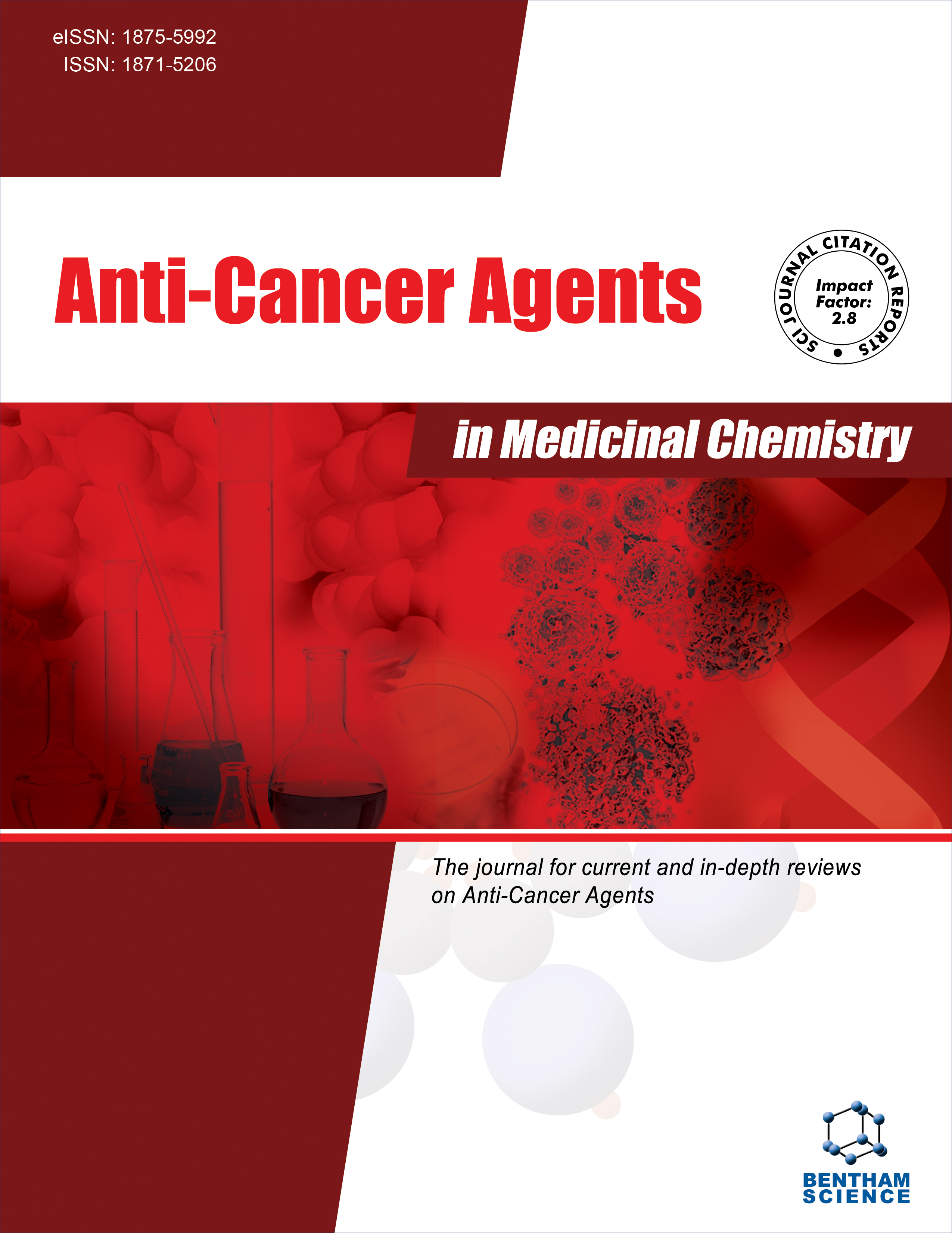- Home
- A-Z Publications
- Anti-Cancer Agents in Medicinal Chemistry (Formerly Current Medicinal Chemistry - Anti-Cancer Agents)
- Previous Issues
- Volume 21, Issue 1, 2021
Anti-Cancer Agents in Medicinal Chemistry (Formerly Current Medicinal Chemistry - Anti-Cancer Agents) - Volume 21, Issue 1, 2021
Volume 21, Issue 1, 2021
-
-
New Developments in Anti-Angiogenic Therapy of Cancer, Review and Update
More LessBackground: Angiogenesis is one of the critical physiological processes, by which the new blood vessels are generated from the pre-existing vessels in the early stage of vasculogenesis. While normal angiogenesis is critical for development and tissue growth, pathologic angiogenesis is important for the growth and spread of cancers by supplying nutrients and oxygen as well as providing a conduit for distant metastasis. In the last Read More
-
-
-
The Ubiquitin-Proteasome Pathway and Epigenetic Modifications in Cancer
More LessAuthors: Azmi Yerlikaya, Ertan Kanbur, Bruce A. Stanley and Emrah TümerBackground: The ubiquitin-proteasome pathway is involved in almost all cellular processes (cell cycle, gene transcription and translation, cell survival and apoptosis, cell metabolism and protein quality control) mainly through the specific degradation of the majority of intracellular proteins (>80%) or partial processing of transcription factors (e.g., NF-ΚB). A growing amount of evidence now indicates that epigenetic changes Read More
-
-
-
New Selenonapthaquinone-Based Copper (II) Complexes as the Next-Generation Photochemotherapeutic Agents
More LessAuthors: Longjam R. Devi, Md. K. Raza, Dulal Musib and Mithun RoyBackground and Objective: Photoactive transition metal complexes like copper complexes find great interest in promoting metal-based photochemotherapeutic agents. In the present study, we explored the photocytotoxic efficacy of new selenylnaphthoquinone-based copper (II) complexes that provide a phenomenal platform in making an effective photo-chemotherapeutic agent via PDT in the clinical field of can Read More
-
-
-
Design, Synthesis, Molecular Docking, and Anticancer Evaluation of Pyrazole Linked Pyrazoline Derivatives with Carbothioamide Tail as EGFR Kinase Inhibitors
More LessBackground: The Epidermal Growth Factor Receptor (known as EGFR) induces cell differentiation and proliferation upon activation through the binding of its ligands. Since EGFR is thought to be involved in the development of cancer, the identification of new target inhibitors is the most viable approach, which recently gained momentum as a potential anticancer therapy. Objective: To assess various pyrazole linked pyraz Read More
-
-
-
Periplogenin Activates ROS-ER Stress Pathway to Trigger Apoptosis via BIP-eIF2α- CHOP and IRE1α-ASK1-JNK Signaling Routes
More LessAuthors: Yingjuan Yang, Yana Liu, Yanhua Zhang, Wei Ji, Lan Wang and Shao C. LeeBackground: Periplogenin (PPG), a natural compound isolated from traditional Chinese herb Cortex Periplocae, has been reported to possess anti-inflammatory and anti-cancer properties. Objective: The present study aims to investigate the antitumor effects of PPG and the underlying mechanism in human colorectal cancer cells. Methods: The inhibition of cell growth in vitro was assessed by MTT assay. The induction of Read More
-
-
-
Oxidovanadium(IV) Complex Disrupts Mitochondrial Membrane Potential and Induces Apoptosis in Pancreatic Cancer Cells
More LessBackground: At the present time, there is a growing interest in metal-based anticancer agents. Metal complexes exhibit many valuable clinical properties, however, due to toxicity, only a few clinically useful complexes have been discovered. It has been demonstrated that synthetic vanadium complexes exhibit many biological activities, including anti-cancer properties, however, cellular and molecular mechanisms sti Read More
-
-
-
Synthesis and Apoptotic Activities of New 2(3H)-benzoxazolone Derivatives in Breast Cancer Cells
More LessAuthors: Emine Erdag, Eda Becer, Yusuf Mulazim, Hafize S. Vatansever, Hilal Kabadayı and Banu KesanliBackground: 2(3H)-Benzoxazolone derivatives are preferential structural blocks in pharmacological probe designing with the possibility of modifications at various positions on the core structure. Benzoxazolones showed various biological activities such as analgesics, anti-inflammatory and anti-cancer. Objective: In the present work, we have prepared new Mannich bases of 2(3H)-benzoxazolone derivatives and evaluate Read More
-
-
-
Photodynamic Effects of Vitamin K3 on Cervical Carcinoma Cells Activating Mitochondrial Apoptosis Pathways
More LessAuthors: Yong Xin, Wenwen Guo, Chunsheng Yang, Qian Huang, Pei Zhang, Longzhen Zhang and Guan JiangBackground: Photodynamic Therapy (PDT) is a photoactivation or photosensitization process, wherein vitamin K3 (Vit K3) serves as a photosensitizer to produce Reactive Oxygen Species (ROS) against bacteria at appropriate wavelengths. In this study, we used Vit K3 treatment combined with Ultraviolet radiation A (UVA) to produce photodynamic effects on cervical cancer. Methods: The dose-concentration relati Read More
-
-
-
Increased Induction of Apoptosis in ESCC (Esophageal Squamous-Cell Carcinoma) by Betula pendula Roth Stem Cell Extract Containing Triterpenoids Compared to Doxorubicin
More LessBackground: Esophageal Squamous-Cell Carcinoma (ESCC) is one of the most life-threatening malignancies worldwide, with a growing incidence in Iran higher than the global average. Objective: The present study, for the first time under patent number (97668), introduces a method using in vitro production of activated-Birch stem cells using biotechnological techniques of tissue culture and plant stem cell culture from Betula Read More
-
-
-
Stimulation of Peroxisome Proliferator-Activated Receptor-Gamma (PPARγ) using Pioglitazone Decreases the Survival of Acute Promyelocytic Leukemia Cells through Up-Regulation of PTEN Expression
More LessBackground: The intertwining between cancer pathogenesis and aberrant expression of either oncogenes or tumor suppressor proteins ushered the cancer therapeutic approaches into a limitless road of modern therapies. For the nonce and among the plethora of promising anticancer agents, intense interest has focused on pioglitazone, a first in-class of Thiazolidinedione (TZD) drugs that is currently used to treat patien Read More
-
Volumes & issues
-
Volume 25 (2025)
-
Volume 24 (2024)
-
Volume 23 (2023)
-
Volume 22 (2022)
-
Volume 21 (2021)
-
Volume 20 (2020)
-
Volume 19 (2019)
-
Volume 18 (2018)
-
Volume 17 (2017)
-
Volume 16 (2016)
-
Volume 15 (2015)
-
Volume 14 (2014)
-
Volume 13 (2013)
-
Volume 12 (2012)
-
Volume 11 (2011)
-
Volume 10 (2010)
-
Volume 9 (2009)
-
Volume 8 (2008)
-
Volume 7 (2007)
-
Volume 6 (2006)
Most Read This Month
Article
content/journals/acamc
Journal
10
5
false
en


